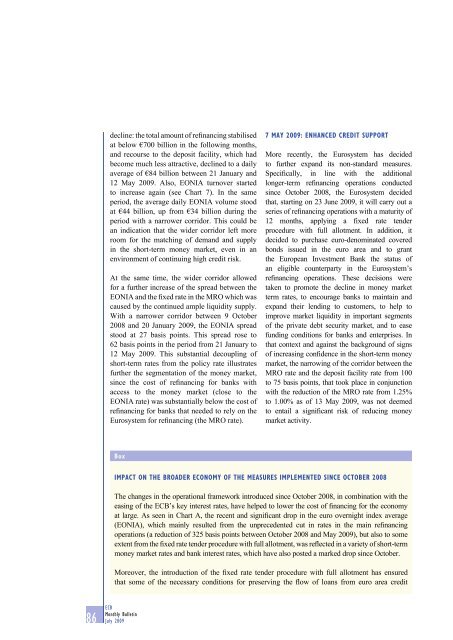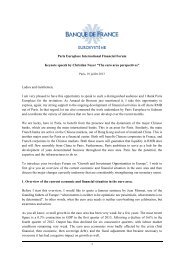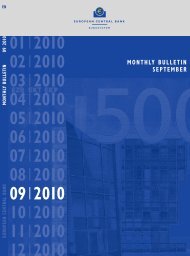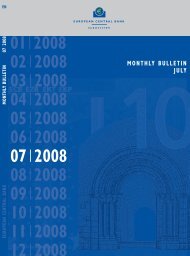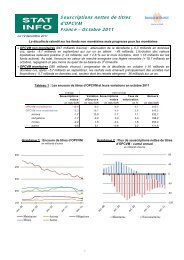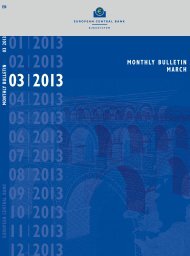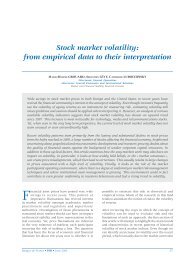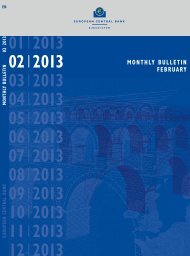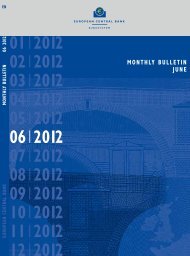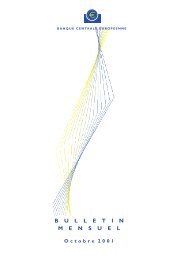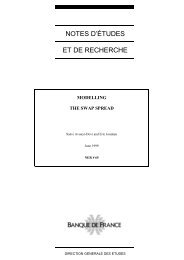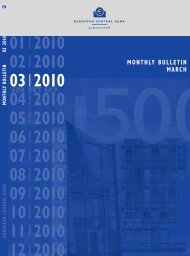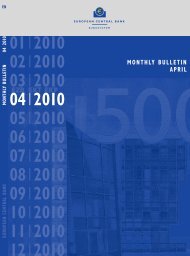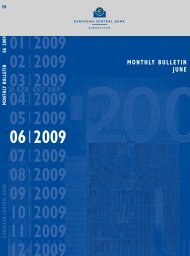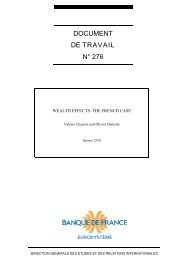Monthly Bulletin July 2009 - Banque de France
Monthly Bulletin July 2009 - Banque de France
Monthly Bulletin July 2009 - Banque de France
Create successful ePaper yourself
Turn your PDF publications into a flip-book with our unique Google optimized e-Paper software.
<strong>de</strong>cline: the total amount of refinancing stabilised<br />
at below €700 billion in the following months,<br />
and recourse to the <strong>de</strong>posit facility, which had<br />
become much less attractive, <strong>de</strong>clined to a daily<br />
average of €84 billion between 21 January and<br />
12 May <strong>2009</strong>. Also, EONIA turnover started<br />
to increase again (see Chart 7). In the same<br />
period, the average daily EONIA volume stood<br />
at €44 billion, up from €34 billion during the<br />
period with a narrower corridor. This could be<br />
an indication that the wi<strong>de</strong>r corridor left more<br />
room for the matching of <strong>de</strong>mand and supply<br />
in the short-term money market, even in an<br />
environment of continuing high credit risk.<br />
At the same time, the wi<strong>de</strong>r corridor allowed<br />
for a further increase of the spread between the<br />
EONIA and the fixed rate in the MRO which was<br />
caused by the continued ample liquidity supply.<br />
With a narrower corridor between 9 October<br />
2008 and 20 January <strong>2009</strong>, the EONIA spread<br />
stood at 27 basis points. This spread rose to<br />
62 basis points in the period from 21 January to<br />
12 May <strong>2009</strong>. This substantial <strong>de</strong>coupling of<br />
short-term rates from the policy rate illustrates<br />
further the segmentation of the money market,<br />
since the cost of refinancing for banks with<br />
access to the money market (close to the<br />
EONIA rate) was substantially below the cost of<br />
refinancing for banks that nee<strong>de</strong>d to rely on the<br />
Eurosystem for refinancing (the MRO rate).<br />
7 MAY <strong>2009</strong>: ENHANCED CREDIT SUPPORT<br />
More recently, the Eurosystem has <strong>de</strong>ci<strong>de</strong>d<br />
to further expand its non-standard measures.<br />
Specifically, in line with the additional<br />
longer-term refinancing operations conducted<br />
since October 2008, the Eurosystem <strong>de</strong>ci<strong>de</strong>d<br />
that, starting on 23 June <strong>2009</strong>, it will carry out a<br />
series of refinancing operations with a maturity of<br />
12 months, applying a fixed rate ten<strong>de</strong>r<br />
procedure with full allotment. In addition, it<br />
<strong>de</strong>ci<strong>de</strong>d to purchase euro-<strong>de</strong>nominated covered<br />
bonds issued in the euro area and to grant<br />
the European Investment Bank the status of<br />
an eligible counterparty in the Eurosystem’s<br />
refinancing operations. These <strong>de</strong>cisions were<br />
taken to promote the <strong>de</strong>cline in money market<br />
term rates, to encourage banks to maintain and<br />
expand their lending to customers, to help to<br />
improve market liquidity in important segments<br />
of the private <strong>de</strong>bt security market, and to ease<br />
funding conditions for banks and enterprises. In<br />
that context and against the background of signs<br />
of increasing confi<strong>de</strong>nce in the short-term money<br />
market, the narrowing of the corridor between the<br />
MRO rate and the <strong>de</strong>posit facility rate from 100<br />
to 75 basis points, that took place in conjunction<br />
with the reduction of the MRO rate from 1.25%<br />
to 1.00% as of 13 May <strong>2009</strong>, was not <strong>de</strong>emed<br />
to entail a significant risk of reducing money<br />
market activity.<br />
Box<br />
IMPACT ON THE BROADER ECONOMY OF THE MEASURES IMPLEMENTED SINCE OCTOBER 2008<br />
The changes in the operational framework introduced since October 2008, in combination with the<br />
easing of the ECB’s key interest rates, have helped to lower the cost of financing for the economy<br />
at large. As seen in Chart A, the recent and significant drop in the euro overnight in<strong>de</strong>x average<br />
(EONIA), which mainly resulted from the unprece<strong>de</strong>nted cut in rates in the main refinancing<br />
operations (a reduction of 325 basis points between October 2008 and May <strong>2009</strong>), but also to some<br />
extent from the fixed rate ten<strong>de</strong>r procedure with full allotment, was reflected in a variety of short-term<br />
money market rates and bank interest rates, which have also posted a marked drop since October.<br />
Moreover, the introduction of the fixed rate ten<strong>de</strong>r procedure with full allotment has ensured<br />
that some of the necessary conditions for preserving the flow of loans from euro area credit<br />
86 ECB<br />
<strong>Monthly</strong> <strong>Bulletin</strong><br />
<strong>July</strong> <strong>2009</strong>


